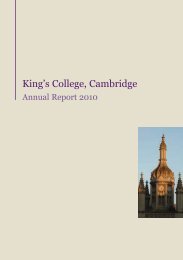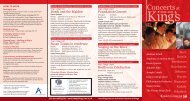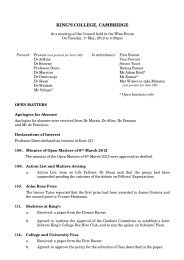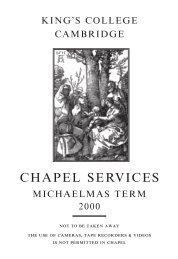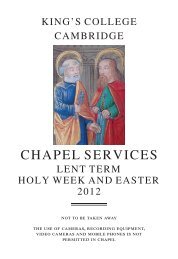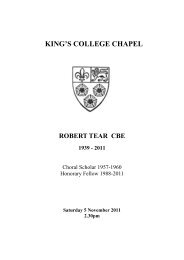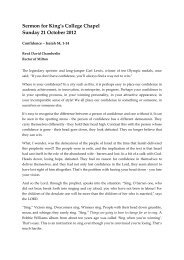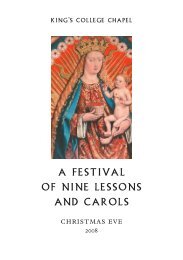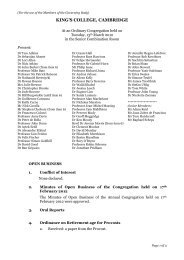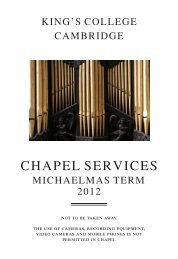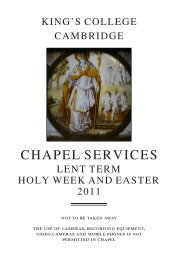Part 2 (Obituaries) - King's College - University of Cambridge
Part 2 (Obituaries) - King's College - University of Cambridge
Part 2 (Obituaries) - King's College - University of Cambridge
You also want an ePaper? Increase the reach of your titles
YUMPU automatically turns print PDFs into web optimized ePapers that Google loves.
CHRISTOPHER ARTHUR EXTON (1958) read Mechanical Sciences at<br />
King’s. He was born in Bury on 7 May 1939 and attended Rossell School. In<br />
1961 he joined English Electric as a graduate apprentice. Christopher stayed<br />
with the company, which later became GEC, ultimately becoming<br />
Manufacturing Manager. After retirement he took up tutoring and voluntary<br />
work and was also the Treasurer <strong>of</strong> the Leicester Philharmonic Society.<br />
Christopher died in Leicester on 11 April 1999.<br />
DAVID STANLEY EVANS (1934) was a vibrant and distinguished astronomer<br />
whose scientific career spanned five continents and nearly 70 years.<br />
Born in Cardiff in 1916 and educated at Cardiff High School for Boys, David<br />
came to King’s to read Mathematics, and was an outstanding student, winning<br />
the Tyson Medal for Astronomy in 1937. His passion for astronomy led him<br />
to a PhD at the <strong>Cambridge</strong> Observatory, where his thesis was on The Formation<br />
<strong>of</strong> the Balmer Series <strong>of</strong> Hydrogen in Stellar Atmospheres. During the war, he registered<br />
as a conscientious objector (a decision he came to question in later life) and<br />
worked as a medical physicist. He also held an appointment as a research<br />
assistant at the <strong>University</strong> Observatory in Oxford, where he worked on solar<br />
spectroscopy, as well as being a scientific adviser for the journal Discovery,<br />
precursor <strong>of</strong> the New Scientist.<br />
David worked for 22 years in South Africa, at the Radcliffe Observatory and<br />
the Royal Observatory. He specialised in obtaining “fundamental” data for the<br />
stars, and this remained the theme <strong>of</strong> David’s research all his life. He was a<br />
pioneer in the use <strong>of</strong> lunar occultation to measure the diameters <strong>of</strong> stars and<br />
separations <strong>of</strong> double stars. After initial scepticism, this work was accepted as<br />
one <strong>of</strong> the few direct methods <strong>of</strong> measuring stellar diameters, but he was<br />
given rather little recognition for it. His legacy is the large amount <strong>of</strong> reliable<br />
data which he and his colleagues published in various papers and catalogues.<br />
Over his lifetime, he produced numerous articles and a large number <strong>of</strong><br />
books, one <strong>of</strong> them with his wife Betty Hall Hart, whom he had married in<br />
1949 and with whom he had two sons.<br />
125<br />
OBITUARIES



